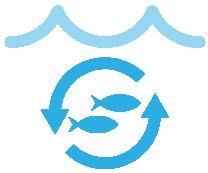The purpose of implementing a science-based, sustainable fishery management system is to improve the long-term wellbeing of the individuals and communities who depend on that fishery. This is likely why you are here exploring the FISHE process – you seek to improve the management of your marine resources so that your fishery and community can continue to thrive well into the future. In order to effectively reform our fisheries and guide our management decisions we must first have an understanding of what might be possible in our system so that we don’t set unrealistic goals and set ourselves up for failure. Some systems can produce millions of tons of yield each year, while others are only capable of much smaller production levels, even if they are managed perfectly.
Traditionally, our understanding of what’s possible and our perspective on what success looks like in any given fishery system have been based on what we have experienced in the past. In other words, we seek to “restore” and “rebuild” our fisheries back to conditions that resemble what they looked like before we fished them too hard. But as climate change progresses, its impacts are altering the most fundamental aspects of marine species and ecosystem functioning. Things that we have historically taken for granted – such as the parts of the world a specific species can inhabit, the “equilibrium” sizes that a population will hover around if given the chance, and even the rate at which a population will reproduce and grow – may be changing. This all means that what was once possible in a given fishery may not be possible in that same fishery in the future.
Adding to the challenge, climate impacts are going to be very different from place to place. As marine species move in an effort to follow their preferred temperature and habitat conditions, impacts on fisheries across the globe may fall into three very general categories. In the highest and lowest latitude regions (e.g., the Arctic), the primary changes will probably involve new species moving in, and new areas opening up to fishing where fishing wasn’t possible before. In the mid-latitudes, primary impacts may involve changes to the mix of species found in any given place and the amount of species biomass available to particular fishing communities, regions, or countries. And, in the equatorial regions, unfortunately, many species are expected to decrease in abundance, or even to disappear completely. However, within these three large-scale generalized patterns there is a significant amount of regional and local variability. For example, upwelling regions will likely experience different patterns of fish abundance and distribution than will non-upwelling areas regardless of latitude, and some parts of the tropics may continue to be productive.
So in order to develop effective, climate-resilient, sustainable fishery management plans that balance conservation and utilization of marine resources over the short- and long-terms, we need to first reimagine what will be possible for our fisheries in the future. This should be based on an understanding of the likely climate change-driven impacts and challenges. Doing so can help us to develop reasonable goals and benchmarks for management, design data collection and scientific assessment regimes that can respond to increased uncertainty, track progress towards these updated benchmarks, and enact effective policies that address changes in fish stocks to facilitate adaptive progress toward our goals. In other words, projections of the likely future conditions in our fisheries should inform our thinking and decision-making at each subsequent step of the FISHE process.
What’s more, modeling different scenarios and projecting different outcomes under different management options can be a powerful motivator of action. Both in contexts where there is a need to garner buy-in and consensus around the need for management reforms, and where different management options are already under consideration, modeling and scenario planning have been used for years in fisheries all over the world to make better-informed decisions. FISHE references a variety of models for projecting fishery outcomes under different management scenarios.
As with stock and habitat status assessments, these types of tools have just recently begun to incorporate climate change data in a meaningful way. Options for data limited fisheries are also available, and we recommend using one or more of these in your fishery to inform your climate-resilient adaptive management plan.
There are some clear global patterns emerging around the expected (and observed) marine system changes stemming from climate impacts – namely that many species will move poleward to track their preferred temperature conditions, leading to overall increases in species abundance and diversity near the poles, changes in species mixes will occur in the mid-latitudes, and there will likely be overall losses in species abundance near the equator. However, local and regional conditions as well as the behavior, physiology, and ecology of marine species will determine the actual distribution and abundance of fish stocks. Hence, there will be a significant amount of variability in species response to climate change at the regional and local scales. This means that in order to make climate-informed decisions, fisheries managers and stakeholders need projections and guidance based on local and regional changes. While regional projections of physical climate impacts such as temperature, sea level rise, and precipitation changes do exist, projections of fish abundance and distribution in response to these changes are often not available at the regional scale. For local scale projections, a significant amount of extrapolation and local knowledge will be required, since local projections of climate change impacts are very rare.
The downloadable “Climate Impact Profile Template” is a document designed to direct users to a set of key resources, including literature and published databases of species’ climate vulnerabilities and observed and expected shift patterns, from which they can extract the available information on likely climate change impacts in their systems. The Template provides a format for capturing this information in a way that will be likely to be valuable to fisheries science and management decision-making.
Future ecosystem conditions will be contingent on cumulative impacts from multiple types of threats and stressors facing the system, including climate change impacts and interactions. The Comprehensive Assessment of Risk to Ecosystems (CARE) model is an Excel-based tool designed to systematically analyze the full suite of risks to selected “targets” (valued species and/ or ecosystems) within a spatially explicit site, from all of the potential “threats” that might impact that site. This tool quantitatively considers the interaction of all system threats and assesses the risk to the entire ecosystem through inclusion of a comprehensive suite of attributes to characterize system resilience. These attributes quantify intrinsic system recovery potential (i.e. “regeneration time” and “connectivity”) and sensitivity to impact (i.e. “removability of system components” and “functional redundancy and diversity”). In 2020 the tool was updated to include an explicit climate vulnerability assessment component that allows users in data limited systems to systematically evaluate the expected impact of climate change on their system in a user-selected future time period, as well as their system's vulnerability to that impact. The scoring process was also updated to allow for generation of climate-impacted relative threat risk scores for all threats present in a site in the same future time period.
The CARE model can be used to evaluate risks facing a single site; to compare multiple sites for suitability/necessity of different management options; or evaluate the effects of a proposed management action aimed at reducing one or more risks. Results of the CARE model can be used to identify which threats are the most important in a given site, and for a given target, both now and in a climate-impacted future. This information can help inform where limited management resources should be directed.
The assessments rely largely on local and expert knowledge, require minimal background research to complete, and can be implemented in the field in a matter of hours. These features make the CARE model singularly well-suited for use in Ecosystem Based Management in data-limited systems, for informing spatially explicit management decisions, and for prioritizing threats for efficient use of management resources.
In addition, a set of (Word Doc) questionnaires are provided to facilitate the collection of information necessary to complete a CARE analysis in the field, through interviews with fishers and other system experts.
Climate vulnerability assessments (CVAs) provide a framework for systematically evaluating climate impacts over a broad range of species to allow for a deeper understanding of the kinds of risks a fishery faces. The CVA method detailed here allows for analysis with existing information, thus making it more accessible in data-limited settings. Most CVA methods (like other risk assessments) combine the exposure of a species to climate change and decadal variability and the sensitivity of species to these stressors. These two components are then combined to estimate an overall vulnerability for each species in the assessment. Quantitative data are used when available, but qualitative information and expert opinion are used when quantitative data is lacking. The US Northeast Climate Vulnerability Assessment developed by scientists at the National Oceanographic and Atmospheric Administration (NOAA) serves as a useful example for how to conduct a regional climate vulnerability assessment (Hare et al. 2016).
We have developed a modified spreadsheet version of this NOAA CVA that can more easily be applied in data-limited and capacity-limited contexts. This spreadsheet tool draws on the Hare methodology to generate overall sensitivity attribute and exposure factor scores using a logic rule formula, while replacing the time-consuming and data-intensive process of quantifying expert certainty in each sensitivity attribute and exposure factor with a more qualitative collaborative scoring process. The spreadsheet also restructures the exposure scoring formula used in the NOAA CVA to differentiate separate scoring components for a magnitude of change score in the region and a spatial overlap score for each species. This differentiation enables users to more rapidly score the likely consequences of the various climate change components that will impact a given region on each species therein and further quantifies the Hare methodology to balance the omission of expert certainty.
For each exposure factor, we provide an overview definition and factor-specific scoring “bin” language to enable accurate scoring without requiring precision. In addition, a more comprehensive list of globally-possible exposure factors is provided, and users are recommended to tailor their selected exposure factors to those relevant in their region of study.
To further improve user clarity around the sensitivity attributes and exposure factors, each variable in the spreadsheet is organized into a group category.
Lastly, the spreadsheet quantifies the directional effect of climate change score by taking the average of individual variable scores.
The spreadsheet tool, as well as the manuscript for the full NOAA analysis by Hare et al. (2016), are provided here, in addition to a primer on how to use our CVA spreadsheet. An example version of the CVA spreadsheet is also provided, prepopulated with three species common to the Caribbean region.





